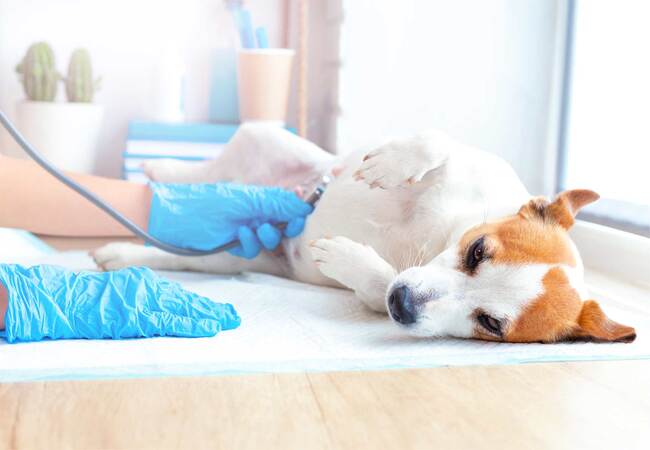Vet’s 2025 Guide to Canine Pyometra 🩺 Emergency Care, Diagnosis & Recovery

In this article
Vet’s 2025 Guide to Canine Pyometra 🩺 Emergency Care, Diagnosis & Recovery
By Dr. Duncan Houston BVSc
💡 What Is Pyometra?
Pyometra is a severe, life-threatening bacterial infection of the uterus that develops several weeks after heat (estrus) due to hormonal changes plus bacterial invasion. It often follows cystic endometrial hyperplasia (CEH), where the uterine lining thickens and cysts form, making the uterus prone to infection.
⚠️ Two Forms: Open vs Closed
- Open pyometra: cervix open—pus drains; visible discharge, but still dangerous.
- Closed pyometra: cervix closed—no discharge, hidden buildup increases risk of rupture, sepsis, shock.
🫁 Who’s at Risk?
- Middle-aged to older intact female dogs—typically 6–10+ years old.
- Nulliparous dogs (never bred) and those on progesterone or estrogen therapies are more susceptible.
- Unspayed bitches have a ~25% risk by age 10, varying by breed.
🚩 Signs & Symptoms
- Pustular to mucoid or bloody vaginal discharge (open form).
- Lethargy, poor appetite, vomiting, increased thirst/urination (“PU/PD”).
- Abdominal enlargement, discomfort, fever, dehydration.
- Severe cases: collapse, shock, sepsis, death if untreated.
🧪 Diagnostic Work-Up
- History & clinical exam: intact female, post-heat cycle, signs of illness.
- Bloodwork: elevated white blood cells, toxins, kidney involvement, dilutional effects from PU/PD.
- Imaging: X-ray shows enlarged, fluid- or gas-filled uterus; ultrasound confirms distended uterine horns filled with echogenic fluid (pus).
🩺 Treatment Options (2025 Standard)
1. Emergency Ovariohysterectomy (Spay) 🏥
- The gold standard removes uterus and ovaries to eliminate the source of infection.
- Pre-op stabilization: IV fluids, broad-spectrum antibiotics (e.g., amoxicillin–clavulanate + enrofloxacin).
- Post-op care: continued antibiotics for ≥14 days, monitor vitals, bloodwork, hydration.
2. Medical Management (Selective) 🌱
- Only for carefully selected breeders or when surgery is high-risk.
- Treatments include:
- Prostaglandins to help expel uterine contents.
- Progesterone antagonists (e.g., aglepristone) or dopamine agonists (cabergoline) to support cervical opening and uterine contraction.
- Strict monitoring with ultrasound, lab tests is suited only to open pyometra without sepsis.
- Pregnancy preservation varies (14–92% success), but ~20% risk recurrence next cycle.
3. Supportive Care
- IV fluids for dehydration, shock, kidney perfusion.
- Correct electrolytes, treat sepsis, and provide pain relief/NSAIDs.
- Hospitalization for 2–5 days depending on severity.
📅 Prognosis & Recovery
- Post-spay: most dogs improve rapidly—eating resumes, hydration normalizes; hospital stay 2–5 days.
- Medical therapy: slower recovery, intensive monitoring; recurrence risk ~20%.
- Untreated closed pyometra mortality is high; risk of rupture, peritonitis, and organ failure.
- Spaying eliminates recurrence; medical therapy retains fertility but carries risk.
🏡 Ask A Vet Home Support
- Log appetite, vomiting, discharge, fluid intake/urination daily.
- Receive reminders for medication doses, rechecks, ultrasound scans.
- Photo logging: abdominal size, vulvar discharge, behavior.
- Receive alerts for warning signs: fever, lethargy, and resumed discharge.
- Post-spay: schedule wellness checks; for medical therapy: track response and plan future breeding cycles.
🔍 Key Takeaways
- Pyometra is a common yet dangerous uterine infection following heat cycles.
- Symptoms may mimic GI or urinary issues—vigilance post-heat is vital.
- Emergency spay with stabilization saves lives; medical therapy is secondary.
- Prompt treatment prevents rupture, sepsis, and death.
- Ask A Vet’s app ensures vigilant home monitoring and continuity of post‑treatment support.
🩺 Conclusion ❤️
In 2025, canine pyometra is best treated through emergency ovary/uterus removal combined with aggressive stabilization. Medical management remains an option for breeding dogs under close supervision. Ask A Vet’s integrated home-care tools—daily tracking, reminders, and vet communications—support optimal recovery and long-term wellness. Prompt action post-heat can save lives and preserve future breeding opportunities. 🐾✨
Visit AskAVet.com and download the Ask A Vet app to track symptoms, receive reminders, upload recovery photos, and stay connected with your vet—wherever you are. 📲






